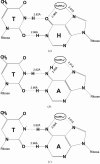Hexammineruthenium(III) ion interactions with Z-DNA
- PMID: 18084080
- PMCID: PMC2344113
- DOI: 10.1107/S1744309107047781
Hexammineruthenium(III) ion interactions with Z-DNA
Abstract
The hexamer duplex d(CGCGCA).d(TGCGCG) was crystallized with hexammineruthenium(III) ions in an orthorhombic space group; the crystals diffracted to 1.54 A resolution. Strong ion interactions with the adenine base induce a tautomeric shift from the amino to the imino form. Consequently, the A.T base pairing is disrupted. This structural study may be relevant to metal toxicity.
Figures






Similar articles
-
Cobalt hexammine induced tautomeric shift in Z-DNA: the structure of d(CGCGCA)*d(TGCGCG) in two crystal forms.Nucleic Acids Res. 2004 Nov 8;32(19):5945-53. doi: 10.1093/nar/gkh919. Print 2004. Nucleic Acids Res. 2004. PMID: 15534365 Free PMC article.
-
Structure of d(TGCGCG).d(CGCGCA) in two crystal forms: effect of sequence and crystal packing in Z-DNA.Acta Crystallogr D Biol Crystallogr. 2005 Aug;61(Pt 8):1125-31. doi: 10.1107/S0907444905016781. Epub 2005 Jul 20. Acta Crystallogr D Biol Crystallogr. 2005. PMID: 16041078
-
Interaction between the Z-type DNA duplex and 1,3-propanediamine: crystal structure of d(CACGTG)2 at 1.2 A resolution.Biochemistry. 2006 Jan 31;45(4):1200-11. doi: 10.1021/bi051569l. Biochemistry. 2006. PMID: 16430216
-
Ultrahigh-resolution centrosymmetric crystal structure of Z-DNA reveals the massive presence of alternate conformations.Acta Crystallogr D Struct Biol. 2016 Nov 1;72(Pt 11):1203-1211. doi: 10.1107/S205979831601679X. Epub 2016 Oct 28. Acta Crystallogr D Struct Biol. 2016. PMID: 27841753
-
DNA architecture: from G to Z.Curr Opin Struct Biol. 2006 Jun;16(3):288-98. doi: 10.1016/j.sbi.2006.05.011. Epub 2006 May 22. Curr Opin Struct Biol. 2006. PMID: 16714104 Free PMC article. Review.
Cited by
-
Crystallization of Z-DNA in Complex with Chemical and Z-DNA Binding Z-Alpha Protein.Methods Mol Biol. 2023;2651:59-67. doi: 10.1007/978-1-0716-3084-6_4. Methods Mol Biol. 2023. PMID: 36892759
-
Predicting accurate ab initio DNA electron densities with equivariant neural networks.Biophys J. 2022 Oct 18;121(20):3883-3895. doi: 10.1016/j.bpj.2022.08.045. Epub 2022 Sep 3. Biophys J. 2022. PMID: 36057785 Free PMC article.
-
Phosphates in the Z-DNA dodecamer are flexible, but their P-SAD signal is sufficient for structure solution.Acta Crystallogr D Biol Crystallogr. 2014 Jul;70(Pt 7):1790-800. doi: 10.1107/S1399004714004684. Epub 2014 Jun 24. Acta Crystallogr D Biol Crystallogr. 2014. PMID: 25004957 Free PMC article.
-
High-resolution crystal structure of Z-DNA in complex with Cr(3+) cations.J Biol Inorg Chem. 2015 Apr;20(3):595-602. doi: 10.1007/s00775-015-1247-5. Epub 2015 Feb 17. J Biol Inorg Chem. 2015. PMID: 25687556 Free PMC article.
-
Interactions of Mn2+ with a non-self-complementary Z-type DNA duplex.Acta Crystallogr Sect F Struct Biol Cryst Commun. 2012 Dec 1;68(Pt 12):1420-6. doi: 10.1107/S1744309112041759. Epub 2012 Nov 14. Acta Crystallogr Sect F Struct Biol Cryst Commun. 2012. PMID: 23192018 Free PMC article.
References
-
- Alessio, E., Mestroni, G., Bergamo, A. & Sava, G. (2004). Curr. Top. Med. Chem.4, 1525–1535. - PubMed
-
- Brabec, V. (2002). Prog. Nucleic Acid Res. Mol. Biol.71, 1–68. - PubMed
-
- Brennan, R. G., Westhof, E. & Sundaralingam, M. (1986). J. Biomol. Struct. Dyn.3, 649–665. - PubMed
-
- Burda, J. V., Sponer, J. & Leszczynski, J. (2000). J. Biol. Inorg. Chem.5, 178–188. - PubMed
-
- Cate, J. H. & Doudna, J. A. (1996). Structure, 4, 1221–1229. - PubMed
Publication types
MeSH terms
Substances
Associated data
- Actions
- Actions
LinkOut - more resources
Full Text Sources

